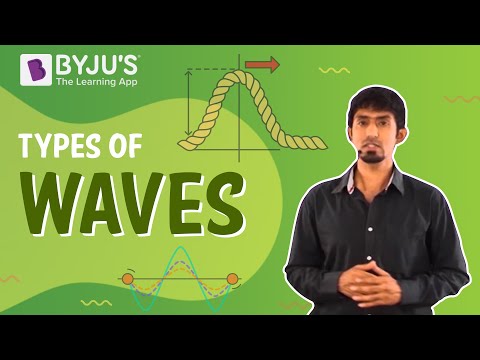A wave is a disturbance in a medium that carries energy without a net movement of particles. It may take the form of elastic deformation, a variation of pressure, electric or magnetic intensity, electric potential, or temperature.
|
Table of Content |
Introduction of Waves
- Transfers energy.
- Usually involves a periodic, repetitive movement.
- Does not result in a net movement of the medium or particles in the medium (mechanical wave).

There are some basic descriptors of a wave. Wavelength is the distance between two successive identical parts of the wave. Amplitude is the maximum displacement from the neutral position. This represents the energy of the wave. Greater amplitude carries greater energy. Displacement is the position of a particular point in the medium as it moves as the wave passes. Maximum displacement is the amplitude of the wave
Frequency (ƒ) is the number of repetitions per second in Hz, Period (T) is the time for one wavelength to pass a point.
The velocity (v) of the wave is the speed at which a specific part of the wave passes a point. The speed of a light wave is c.
Types of Waves:
The types of waves are given below.
Transverse Waves
Waves in which the medium moves at right angles to the direction of the wave.
Examples of transverse waves:
- Water waves (ripples of gravity waves, not sound through water)
- Light waves
- S-wave earthquake waves
- Stringed instruments
- Torsion wave
The high point of a transverse wave is a crest. The low part is a trough.
Longitudinal Wave:
A longitudinal wave has the movement of the particles in the medium in the same dimension as the direction of movement of the wave.
Examples of longitudinal waves:
- Sound waves
- P-type earthquake waves
- Compression wave
Parts of longitudinal waves:
Compression: where the particles are close together.
Rarefaction: where the particles are spread apart.
Now that we know the types of waves, let’s see the below video to understand how exactly the particles move in these wave types:

Mechanical waves:
A wave which needs a medium in order to propagate itself. Sound waves, waves in a slinky, and water waves are all examples of this.
Matter Waves:
Any moving object can be described as a wave When a stone is dropped into a pond, the water is disturbed from its equilibrium positions as the wave passes; it returns to its equilibrium position after the wave has passed.
Electromagnetic Waves:
These waves are disturbance that does not need any object medium for propagation and can easily travel through the vacuum. They are produced due to various magnetic and electric fields. The periodic changes that take place in magnetic and electric fields and therefore known as electromagnetic waves.

Read More: Electromagnetic Waves
Wave Speed Formula
It is the total distance covered by the wave in a given time period. The formula for wave speed is given as,
Wave Speed = Distance Covered/Time taken
Properties of Waves
The prime properties of waves are as follows:
Amplitude – Wave is an energy transport phenomenon. Amplitude is the height of the wave, usually measured in metres. It is directly related to the amount of energy carried by a wave.
Wavelength – The distance between identical points in the adjacent cycles of crests of a wave is called a wavelength. It is also measured in metres.
Period – The period of a wave is the time for a particle on a medium to make one complete vibrational cycle. As the period is time, hence is measured in units of time such as seconds or minutes.
Frequency – Frequency of a wave is the number of waves passing a point in a certain time. The unit of frequency is hertz (Hz) which is equal to one wave per second.
The period is the reciprocal of the frequency and vice versa.
OR
Speed – The speed of an object means how fast an object moves and is usually expressed as the distance travelled per time of travel. The speed of a wave refers to the distance travelled by a given point on the wave (crest) in a given interval of time. That is –
Speed of a wave is thus measured in metre/second i.e. m/s.
Watch the video and study Heat, Waves * Optics JEE PY Questions

Frequently Asked Questions
What is a wave?
Define frequency of a wave.
Define amplitude of a wave.
What are electromagnetic waves?
Give some examples of electromagnetic waves.
electromagnetic waves.
Stay tuned with BYJU’S to learn more about wave and other related concepts with interesting video lectures.

Thanks for the note
Is this an important chapter for neet 2021
Nice notes 👌👌👌👌
what is a wave transmitted by?
A wave is defined as a disturbance or variation that transfers energy progressively from point to point in a medium and that may take the form of elastic deformation or of a variation of pressure, electric or magnetic intensity, electric potential, or temperature.
Supper notes
I need full notes of waves
Class 11
Thanks for the note
Thank you!
It was so helpful!!
Thanks for write up
Nice teaching
I really appreciate the teaching
Please, explain chapter simple harmonic motion and wave motion 🙏
Hi,
You might find the below articles helpful:
Thanks for write up it was very helpfull
Please could you explain about “transverse wave propagation along stretched string?”
A detailed explanation regarding transverse wave propagation along a stretched string is given on the following page, please check: https://byjus.com/physics/transverse-waves/